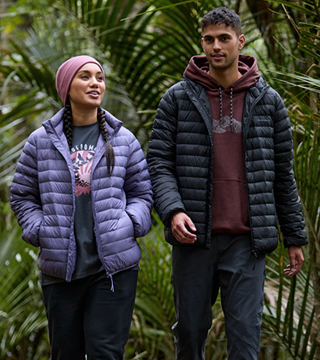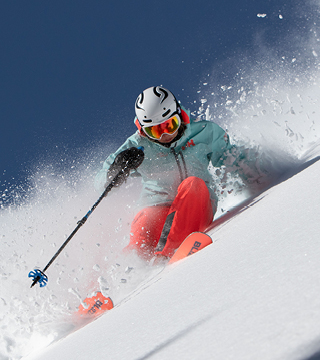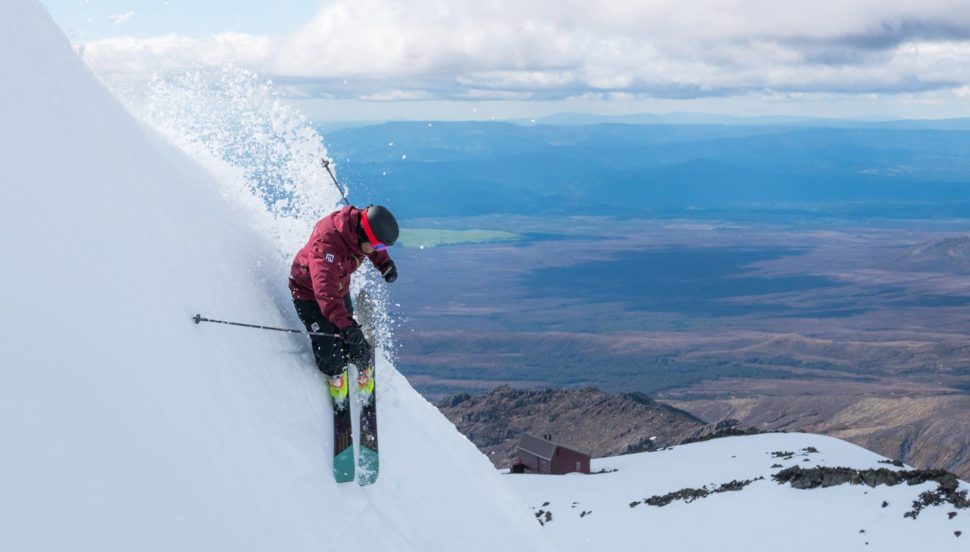Winter snow has hit, and the mountain is calling your name…Get your skis on! If you’re looking for your first set of skis, or want to try something different, our snow specialists in store can help to determine what kind of skis you’ll need! As a general guide, check out the info below and we’ll have you shredding snow in no time!

Step 1: What Type of Skis do you need?
There are many different shapes and sizes of skis, but below is a basic outline of the shapes available. Be sure to choose a set of skis that match your ability, and the type of snow you want to ski.
- All-mountain wide – good in a mix of soft snow and groomed slopes
- Freestyle – for those who spend most of their time at the terrain park
- Powder/backcountry – good for deep powder and backcountry skiing
All-mountain wide:
With waists measuring 91mm – 109mm these skis are for hitting all sections of the mountain and can handle it all. From groomers to heavy snow and everything in between, the thicker waist on these skis will take it all on!
Freestyle:
With a narrower waist (up to 90mm), these skis are for people who spend most of their time skiing at the terrain park. If you’re hitting every rail and jump in the park, or jibs are what you’re in to, then a set of freestyle skis are what you’re after.
Powder/backcountry:
These skis will have the widest waists, at over 100mm for women and 109mm for men and are made for skiing off piste. The thicker waists allow you to float above deep snow in the backcountry slopes, you hard core ripper you!
Step 2: Choosing the Right Size Skis
There are many factors to take in to consideration when choosing the length of skis. In general, the tip of the ski should reach to between your nose and eyebrows when the tail is standing on the ground. Chat with a Torpedo7 team member in store for help with choosing the right ski for you, but as a general guide, see size chart below:
| Skier Height (cm) | Suggested Ski Lengths (cm) |
| 132 | 115-130 |
| 137 | 125-140 |
| 142 | 130-145 |
| 147 | 135-150 |
| 152 | 135-155 |
| 158 | 145-165 |
| 163 | 150-170 |
| 168 | 155-175 |
| 173 | 160-180 |
| 178 | 165-185 |
| 183 | 170-190 |
| 188 | 175-195 |
| 193 | 180-200 |
Shop Skis
Features for the Hardcore Frothers!
Waist width
The waist refers to the width of the ski at its narrowest point, ranging from about 68mm – 130mm. The narrower the ski, the shorter the time it takes to transition from one edge to the other and allowing nice quick carves downhill. If skiing on softer snow, look for a wider ski that will ‘float’ on top.
Turn Radius
This is the size of a carved turn that the ski would do in perfect conditions. The smaller this number, the quicker turning and shorter turns the ski prefers to make. The larger the number, the longer the carved turn that the ski prefers to make.
Shorter turning skis like to be skied at slow to medium speeds and be carved. Stick to the groomed/prepared slopes as these like the snow to be smooth and hard.
Long turn radius skis prefer higher speeds and/or to be skied off-piste due to the long turn radius.
Rocker/Camber
This is the bow or upsweep of a ski if you were to lay it on a flat surface. If the ski sweeps up toward the tip and tail, it’s called rocker. If the ski only touches at the tip and tail and the middle is lifted, it’s called camber.
Rocker lifts the wider parts of the ski off the snow which gives a “catch free” feeling when running the ski flat and transitioning from edge to edge.
Camber gives a spring effect to a ski. As you load it up with weight and the forces of gravity, a cambered ski will naturally want to return to its original position. This helps propel you from one turn to another and makes a ski feel “poppy.”
Tip/Tail Taper
This is moving the widest parts of the ski closer to the centre of the ski, creating an elongated look to the tip and/or tail.
Skis will have varying tip and tail taper to suit their primary intended terrain.
Ski Core
Cores are very complex these days on skis. You will find many types of metal, wood, carbon fiber, Kevlar, basalt, fiberglass, resin, nomex, honeycombs, korroyd, foam and whatever else is the new material of the year that makes a ski better for you.
Heavier and more aggressive skiers require stiffer skis that they can bend and push around the hill. Stiffer skis also hold an edge better and return more energy to the skier, rewarding those that can push them.
Softer skis require less effort to flex. These skis are easier to manipulate and can feel more playful. They favour lighter and less aggressive skiers. These skis will also let loose earlier, which will feel skittish to aggressive and heavy skiers.

















